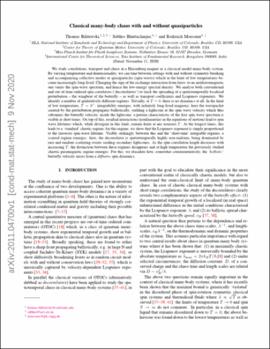| dc.contributor.author | Bilitewski, Thomas | |
| dc.contributor.author | Bhattacharjee, Subhro | |
| dc.contributor.author | Moessner, Roderich | |
| dc.date.accessioned | 2022-10-18T21:55:39Z | |
| dc.date.available | 2022-10-18T21:55:39Z | |
| dc.date.issued | 2020-11-09 | |
| dc.identifier.citation | Bilitewski, T., Bhattacharjee, S., Moessner, R. (2020). Classical many-body chaos with and without quasiparticles. | |
| dc.identifier.uri | https://hdl.handle.net/11244/336568 | |
| dc.description.abstract | We study correlations, transport and chaos in a Heisenberg magnet as a classical model many-body system. By varying temperature and dimensionality, we can tune between settings with and without symmetry breaking and accompanying collective modes or quasiparticles (spin-waves) which in the limit of low temperatures become increasingly long-lived. Changing the sign of the exchange interaction from ferro- to an antiferromagnetic one varies the spin-wave spectrum, and hence the low-energy spectral density. We analyse both conventional and out-of-time-ordered spin correlators (‘decorrelators’) to track the spreading of a spatiotemporally localised perturbation – the wingbeat of the butterfly – as well as transport coefficients and Lyapunov exponents. We identify a number of qualitatively different regimes. Trivially, at T = 0, there is no dynamics at all. In the limit of low temperature, T = 0+, integrability emerges, with infinitely long-lived magnons; here the wavepacket created by the perturbation propagates ballistically, yielding a lightcone at the spin wave velocity which thus subsumes the butterfly velocity; inside the lightcone, a pattern characteristic of the free spin wave spectrum is visible at short times. On top of this, residual interactions (nonlinearities in the equations of motion) lead to spin wave lifetimes which, while divergent in this limit, remain finite at any nonzero T. At the longest times, this leads to a ‘standard’ chaotic regime; for this regime, we show that the Lyapunov exponent is simply proportional to the (inverse) spin-wave lifetime. Visibly strikingly, between this and the ‘short-time’ integrable regimes, a scarred regime emerges: here, the decorrelator is spatiotemporally highly non-uniform, being dominated by rare and random scattering events seeding secondary lightcones. As the spin correlation length decreases with increasing T, the distinction between these regimes disappears and at high temperature the previously studied chaotic paramagnetic regime emerges. For this, we elucidate how, somewhat counterintuitively, the ‘ballistic’ butterfly velocity arises from a diffusive spin dynamics. | |
| dc.format | application/pdf | |
| dc.relation.uri | http://arxiv.org/abs/2011.04700v1 | |
| dc.relation.uri | http://dx.doi.org/10.1103/PhysRevB.103.174302 | |
| dc.rights | This material has been previously published. In the Oklahoma State University Library's institutional repository this version is made available through the open access principles and the terms of agreement/consent between the author(s) and the publisher. The permission policy on the use, reproduction or distribution of the material falls under fair use for educational, scholarship, and research purposes. Contact Digital Resources and Discovery Services at lib-dls@okstate.edu or 405-744-9161 for further information. | |
| dc.title | Classical many-body chaos with and without quasiparticles | |
| dc.date.updated | 2022-10-03T14:24:42Z | |
| dc.description.department | Physics | |
| dc.type.genre | Preprint | |
| dc.type.material | Text | |
| dc.subject.keywords | cond-mat.stat-mech | |
| dc.identifier.author | ORCID: 0000-0002-9971-1835 (Bilitewski, Thomas) | |
